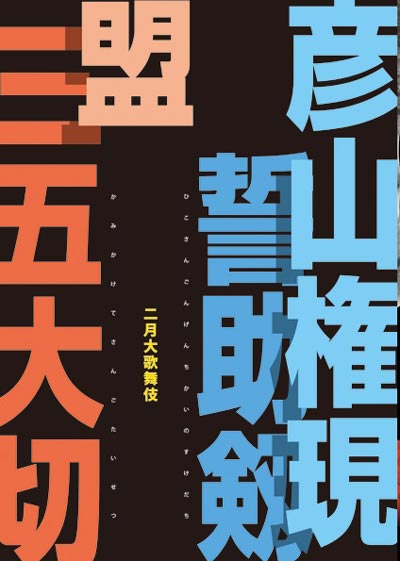| Comments |
Kuzu-no-Ha: Abe no Yasuna, a court astrologer in disgrace, has married a beautiful
woman named Kuzu-no-Ha, not knowing that she is actually a fox that has taken human
form to repay his kindness in saving his life. The couple has a child and lives
happily together until the real woman whose form the fox borrowed appears.
Knowing that she can no longer stay, Kuzu-no-Ha writes a tearful farewell poem on
the paper screen and returns to the wilderness. Starring Nakamura Fukusuke as Kuzu-no-Ha and Nakamura T˘z˘ as Yasuna.
Kanjinch˘: probably the most popular Kabuki play today,
it includes dance, comedy and the heart-warming pathos of a band of heroes
during their last days. Disguised as a band of traveling priests the
fugitive general Yoshitsune and his small band of retainers are stopped at a
road barrier. They escape only through the quick thinking of the head retainer,
a warrior priest named Musashib˘ Benkei, who improvises the text of an elaborate imperial
decree. Having escaped danger Benkei and the others describe their days of
glory and hardships on the road to escape in a moving dance.
This program stars Ichikawa Danjűr˘ in the role of Benkei,
with Nakamura Shichinosuke and Nakamura Baigyoku as Yoshitsune and the barrier keeper Togashi.
Genjidana: Yosabur˘ (Nakamura Baigyoku) fell in love with Otomi (Nakamura Fukusuke) the moment he first saw her on the beach.
Otomi was the mistress of a powerful gangster and, when their relationship
was discovered, Yosabur˘ was cut from head to toe and
the two were dumped into the sea. Otomi lived and was taken in by a rich
merchant. Yosabur˘, who is now covered with scars, turns into
a petty thief and extortionist but one day, finds that the woman he is
about to blackmail is none other than Otomi, alive and well.
Yoshitsune Senbon Zakura: this is section of an epic originally
written for the Bunraku puppet theatre.
The full-length play shows the fate of various Heike generals in hiding after
the victory of their enemy, the Genji.
Konomi/Kokingo Uchijini:
(The Chestnut Tree and The Death of Kokingo)
Wakaba-no-Naishi (Nakamura Shinobu), the wife of the Heike commander Koremochi travels with
her young son and their retainer Kokingo (Nakamura Shichinosuke), searching for her husband.
While resting in a small mountain village, they are met by Gonta (Ichikawa Danjűr˘),
a local bully who skillfully cons them out of their money. Later they are set upon
by Genji forces, and in a spectacular fight scene, Kokingo sacrifices himself to
save his mistress and her son.
Sushiya:
(The Sushi Shop)
Gonta's father Yazaemon (Kataoka Ichiz˘) runs a sushi shop,
but was formerly a retainer of Taira Koremochi. With his clan defeated,
Koremochi (Nakamura Baigyoku) now lives with Yazaemon's family disguised as a humble apprentice.
Innocently, Yazaemon's daughter, Osato (Nakamura Fukusuke) is in love with him.
But knowing of the bounty on Koremochi's head, her brother Gonta kills him and
turns his wife and child over to the Genji commander. Furious at his son,
Yazaemon stabs him, but before his death, Gonta reveals that he only
pretended to kill Koremochi and sacrificed his own wife and son to save
the real Koremochi and his family.
Ninin D˘j˘ji: a beautiful young woman dances under cherry blossoms
at a dedication ceremony for a temple bell. She dances the many aspects of a
woman in love, but is actually the spirit of a serpent, driven to destroy the
bell out of jealousy. In addition to being the most famous of all Kabuki dances,
"Musume D˘j˘ji" is considered to be the pinnacle of the art of the onnagata
female role specialist. Starring Nakamura Fukusuke in a special double version together with young onnagata actor Nakamura Shichinosuke.
Source: Earphone Guide website
|


